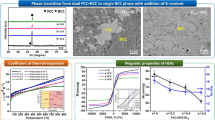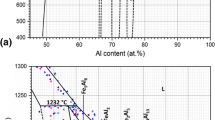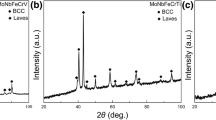Abstract
The oxygen solubility in Fe-Si melts in equilibrium with SiO2 at 1873 K has been determined in a concentration range of 0.1–70 wt % Si. Model alloys are melted in quartz crucibles in an argon atmosphere. The oxygen content in analytical samples is determined by the inert-gas reducing-fusion method after careful sample preparation. The results obtained have been processed using a thermodynamic model that can calculate the oxygen activity and solubility in Fe-Si melts up to 100 wt % Si. The effects of the heating rate and the silicon content on the carbon concentration in carbonyl iron and Fe-Si alloys are studied using the inert-gas reducing-fusion method in the temperature range 1673–2373 K. Oriented electrical steels are investigated using fractional gas analysis. The main forms of oxygen in these steels are found to be silicates, Al2O3, and MgAl2O4.
Similar content being viewed by others
References
T. Rosa, D. Ruiza, Y. Houbaerta, and R. E. Vandenberghe, “Study of Ordering Phenomena in High Silicon Electrical Steel (up to 12.5 at %) by Mössbauer Spectroscopy,” J. Magn. Magn. Mater. 242–245, 208–211 (2002).
C. Hsin-Min and J. Chipman, “The Chromium-Oxygen Equilibrium in Liquid Iron,” Trans. ASM 38, 70–116 (1947).
Steelmaking Data Sourcebook (Gordon & Breach, New York, 1988).
N. A. Goken and J. Chipman, “Silicon-Oxygen Equilibrium in Liquid Iron,” Trans. TMS-AIME 194, 171–181 (1952).
S. Tszen-Tszi, A. Yu. Polyakov, and A. M. Samarin, “Oxygen Solubility in Liquid Iron-Silicon Alloys at Atmospheric Pressure under Vacuum,” Izv. Akad. Nauk SSSR, OTN Metallurgiya i Toplivo, No. 2, 115–118 (1961).
T. Narushima, K. Matsuzawa, Y. Mukai, and Y. Iguchi, “Oxygen Solubility in Liquid Silicon,” Mater. Trans. 35(8), 522–528 (1994).
K. Yanaba, Y. Matsumura, T. Narushima, and Y. Iguchi, “Effect of Alloying Elements on the Carbon Solubility in Liquid Silicon Equilibrated with Silicon Carbide,” Mater. Trans. 39(8), 819 (1998).
K. V. Grigorovitch, “Fractional Gas Analysis—a New Trend in Quality Control,” Anal. Kontr. 4(3), 244–251 (2000).
K. V. Grigorovitch, P. V. Krasovskii, S. A. Isakov, et al., “Processing and Interpretation of Fractional Gas Analysis Results,” Zavod. Lab. 68(9), 3–9 (2002).
P. V. Krasovskii and K. V. Grigorovitch, “Thermodynamics of Nonisothermal Reduction of Oxide Inclusions in Carbon-Saturated Melts,” Izv. Ross. Akad. Nauk, Ser. Met., No. 2, 10–16 (2002) [Russian Metallurgy (Metally), No. 2, 114–117 (2002)].
N. M. Chuiko, E. I. Moshkevich, A. T. Perevyazko, and Yu. P. Galitskii, Transformer Steel (Metallurgiya, Moscow, 1970) [in Russian].
Y. Kurosaki, M. Shiozaki, K. Higashine, and M. Sumimoto, “Effect of Oxide Shape on Magnetic Properties of Semiprocessed Nonoriented Electrical Steel Sheets,” ISIJ Int. 39(6), 607–613 (1999).
V. A. Sinel’nikov and B. S. Ivanov, Casting of Low-Carbon Electrical Steel (Metallurgiya, Moscow, 1991) [in Russian].
F. Ishii and S. Ban-ya, “Deoxidation Equilibrium of Silicon in Liquid Nickel and Nickel-Iron Alloys,” ISIJ Int. 32(10), 1091–1096 (1992).
R. W. Shaw, R. Bredeweg, and P. Rosseto, “Gas Fusion Analysis of Oxygen in Silicon: Separation of Components,” J. Electrochem. Soc. 138(2), 582–584 (1991).
T. Ise, Y. Nuri, Y. Kato, et al., “The Effect of Heating Conditions on the Removal of Oxide Film on Steel Surface by the Inert Gas Fusion Method,” ISIJ Int. 38(12), 1362–1368 (1998).
V. K. Grigorovitch, Electronic Structure and Thermodynamics of Iron Alloys (Nauka, Moscow, 1970) [in Russian].
P. V. Krasovskii, K. V. Grigorovitch, and W. Gruner, “Comparative Study of Oxide Speciation in Steel by Inert Gas Fusion Technique,” Steel Res. Int. 77(1), 50–58 (2006).
H. Hirata and K. Hoshikawa, “Oxygen Solubility and Its Temperature Dependence in a Silicon Melt in Equilibrium with Solid Silica,” J. Cryst. Growth 106, 657–664 (1990).
S. S. Shibaev, P. V. Krasovskii, and K. V. Grigorovitch, “Solubility of Oxygen in Iron-Silicon Melts in Equilibrium with Silica at 1873 K,” ISIJ Int. 45(9), 1243–1247 (2005).
I. Prigogine and R. Defay, Chemical Thermodynamics (Longmans Green and Co., London, 1954; Nauka, Novosibirsk, 1966).
G. V. Belov, V. S. Iorish, and V. S. Yungman, “IVTANTHERMO for Windows—Database on Thermodynamic Properties and Related Software,” CALPHAD 23(2), 173–180 (1999).
A. I. Zaitsev, M. A. Zemchenko, and B. M. Mogutnov, “Thermodynamic Properties of {(1 − x)Si + xFe}(I),” J. Chem. Thermodyn. 23, 831–849 (1991).
D. Janke and W. Fisher, “Thermochemical Data for the Reactions 2Cr + 3/2O2 = Cr2O3, Mo + O2 = MoO2 and SO2 = [O] in Liquid Iron,” Arch. Eisenhuttenwes 46(12), 755–760 (1975).
Y. Kita, J. B. Van Zytveld, Z. Morita, and T. Iida, “Covalency in Liquid Si and Liquid Transition-Metal-Si Alloys: X-ray Diffraction Studies,” J. Phys.: Condens. Matter 6(4), 811–820 (1994).
M. G. Frohberg and M. Wang, “Thermodynamic Properties of Sulphur in Liquid Copper-Antimony Alloys at 1473 K,” Z. Metallkd. 81(7), 513–515 (1990).
P. V. Krasovskii and K. V. Grigorovitch, “Thermodynamics of Iron-Carbon Melts with Silicon or Aluminum,” Izv. Ross. Akad. Nauk, Ser. Met., No. 4, 7–16 (2001) [Russian Metallurgy (Metally), No. 4, 337–345 (2001)].
F. Neumann, H. Schenck, and W. Patterson, “Eisen-Kohlenstoff-Legierungen in Thermodynamischer Betrachtung,” Giess.-Wissen, No. 23, 1217–1246 (1959).
Author information
Authors and Affiliations
Additional information
Original Russian Text © S.S. Shibaev, K.V. Grigorovitch, 2006, published in Metally, 2006, No. 2, pp. 14–27.
Rights and permissions
About this article
Cite this article
Shibaev, S.S., Grigorovitch, K.V. Deoxidation with silicon and the control of oxide inclusions in electrical steels. Russ. Metall. 2006, 108–118 (2006). https://doi.org/10.1134/S0036029506020029
Received:
Issue Date:
DOI: https://doi.org/10.1134/S0036029506020029




